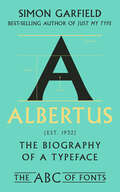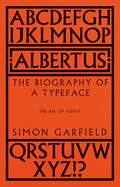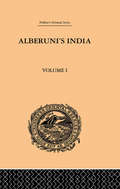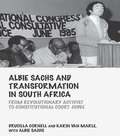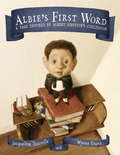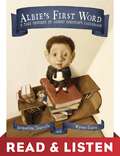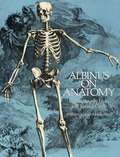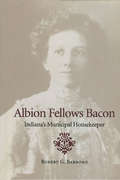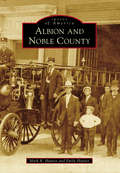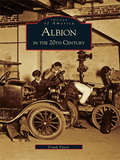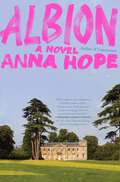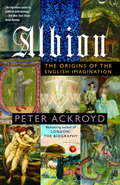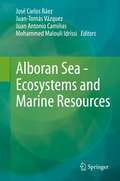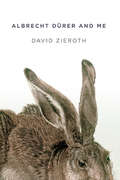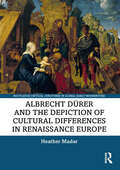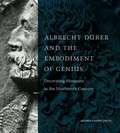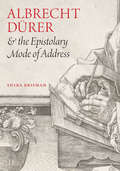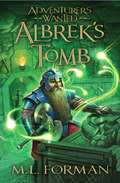- Table View
- List View
Albertus: The Biography of a Typeface (The ABC of Fonts Series #0)
by Simon GarfieldA compact and charming history of the beloved handcrafted font by the New York Times best-selling author of Just My Type. Albertus, first carved on a bronze tablet in the 1930s by German Jewish refugee Berthold Wolpe, has proved to be one of the most enduring handcrafted typefaces in the world. It is at once modern and timeless, authoritative and whimsical—renowned as the typeface of London Street signs, David Bowie albums, and Star Wars movie posters. In this unique celebration, best-selling author Simon Garfield charts the story of the creation of Albertus, its innumerable and vibrant uses, and the erratic brilliance of its designer, as recounted by Wolpe’s children. Through his exploration of this singular font, Garfield grapples with one of the most fundamental artistic questions: what makes great art not only survive but flourish in each new age and medium?
Albertus: The Biography of a Typeface (The ABC of Fonts) (The ABC of Fonts)
by Simon GarfieldOne of the most beautiful handcrafted typefaces in the world, Albertus is also one of the most enduring. The face of thousands of book jackets, and the chosen look for David Bowie, Coldplay, Star Wars and London street signs, Albertus is as as warmly enticing on film posters as it is on memorial plaques.The story of the font is one displacement (its designer Berthold Wolpe was a German Jewish refugee who went on to design the masthead for The Times), but also one of permanence, for it has proved a fresh, vibrant and indestructible face for almost a century. In this unique celebration, the designer's children reveal the history of its creation and the erratic brilliance of their father, while the book grapples with one of the fundamental artistic questions: what makes great art not only survive but flourish in each new age and medium?
Albert’s Way: The First North American Congress on the Carmelite Rule
by Michael MulhallThe book deals with the Carmelites who represented one offshoot of the rich, fervent and creative society that formed Europe's medieval--from about 1100 until 1500--and particularly Norman, society.
Alberuni's India: An Account of the Religion, Philosophy, Literature, Geography, Chronology, Astronomy, Customs, Laws and Astrology of India: Volume I
by Edward C. SachauThis is Volume IX of eleven in a collection of India: History, Economy and Society. Originally published in 1910, this is the first part of an account of the religion, philosophy, literature, geography, chronology, astronomy, customs, laws and astrology of Alberuni's India about A.D. 1030.
Alberuni's India: An Account of the Religion, Philosophy, Literature, Geography, Chronology, Astronomy, Customs, Laws and Astrology of India: Volume II
by Edward C. SachauThis is Volume X of eleven in a collection of India: History, Economy and Society. Originally published in 1910, this is the second part of an account of the religion, philosophy, literature, geography, chronology, astronomy, customs, laws and astrology of Alberuni's India about A.D. 1030.
Albie Sachs and Transformation in South Africa: From Revolutionary Activist to Constitutional Court Judge (Birkbeck Law Press)
by Albie Sachs Drucilla Cornell Karin van MarleMany critical theorists talk and write about the day after the revolution, but few have actually participated in the constitution of a revolutionary government. Emeritus Justice Albie Sachs was a freedom fighter for most of his life. He then played a major role in the negotiating committee for the new constitution of South Africa, and was subsequently appointed to the new Constitutional Court of South Africa. Therefore, the question of what it means to make the transition from a freedom fighter to a participant in a revolutionary government is not abstract, in Hegel’s sense of the word, it is an actual journey that Albie Sachs undertook. The essays in this book raise the complex question of what it actually means to make this transition without selling out to the demands of realism. In addition, the preface written by Emeritus Justice Albie Sachs and his interview with Drucilla Cornell and Karin van Marle, further address key questions about revolution in the twentieth- and twenty-first centuries: from armed struggle to the organization of a nation state committed to ethical transformation in the name of justice. Albie Sachs and transformation in South Africa: from revolutionary activist to constitutional court judge illuminates the theoretical and practical experiences of revolution and its political aftermath. With first-hand accounts alongside academic interrogation, this unique book will intrigue anyone interested in the intersection of Law and Politics.
Albie's First Word: A Tale Inspired by Albert Einstein's Childhood
by Wynne Evans Jacqueline TourvilleHere's a beautiful historical fiction picture book--perfect for the Common Core--that provides a rare glimpse into the early childhood of Albert Einstein, the world's most famous physicist. Three-year-old Albie has never said a single word. When his worried mother and father consult a doctor, he advises them to expose little Albie to new things: a trip to the orchestra, an astronomy lecture, a toy boat race in the park. But though Albie dances with excitement at each new experience, he remains silent. Finally, the thoughtful, quiet child witnesses something so incredible, he utters his very first word: "Why?" Kids, parents, and teachers will be delighted and reassured by this joyous story of a child who develops a bit differently than others."More than a distinctive introduction to Albert Einstein, this book promotes both understanding of difference and scientific curiosity." --Kirkus Reviews, StarredFrom the Hardcover edition.
Albie's First Word: Read & Listen Edition
by Jacqueline TourvilleHere&’s a beautiful historical fiction picture book that provides a rare glimpse into the early childhood of Albert Einstein, the world&’s most famous physicist. Three-year-old Albie has never said a single word. When his worried mother and father consult a doctor, he advises them to expose little Albie to new things: a trip to the orchestra, an astronomy lecture, a toy boat race in the park. But though Albie dances with excitement at each new experience, he remains silent. Finally, the thoughtful, quiet child witnesses something so incredible, he utters his very first word: &“Why?&” Kids, parents, and teachers will be delighted and reassured by this joyous story of a child who develops a bit differently than others.This Read & Listen edition contains audio narration.
Albinus on Anatomy
by Robert Beverly Hale Terence CoyleAll 80 of the great 18th-century descriptive anatomist's original copperplate engravings of the human skeletal and muscular systems, containing 230 individual illustrations, are reproduced in this edition. Muscles and bones are rendered individually and in related groups from varying perspectives. A work of great scientific merit, this volume is a magnificent work of art as well.
Albion (Images of America)
by Avis A. TownsendAlbion highlights a historic community in the Lake Ontairo region of western New York State. With vintage photographs and fascinating detail, the book records Courthouse Square, early salt roads and quarries, splendid cobblestone houses, the Erie Canal passing through town, famous resident George Pullman, Rich's Corners, two correctional facilities, and the outstanding garden-style Mount Albion Cemetery.
Albion Fellows Bacon: Indiana's Municipal Housekeeper
by Robert G. BarrowsAlbion Fellows BaconIndiana’s Municipal HousekeeperRobert G. BarrowsExamines the career of a leading Progressive Era reformer.Born in Evansville, Indiana, in 1865, Albion Fellows was reared in the nearby hamlet of McCutchanville and graduated from Evansville High School. She worked for several years as a secretary and court reporter, toured Europe with her sister, married local merchant Hilary Bacon in 1888, and settled into a seemingly comfortable routine of middle-class domesticity. In 1892, however, she was afflicted with an illness that lasted for several years, an illness that may have resulted from a real or perceived absence of outlets for her intelligence and creativity.Bacon eventually found such outlets in a myriad of voluntary associations and social welfare campaigns. She was best known for her work on behalf of tenement reform and was instrumental in the passage of legislation to improve housing conditions in Indiana. She was also involved in child welfare, city planning and zoning, and a variety of public health efforts. Bacon became Indiana’s foremost "municipal houskeeper," a Progressive Era term for women who applied their domestic skills to social problems plaguing their communities.She also found time to write about her social reform efforts and her religious faith in articles and pamphlets. She published one volume of children’s stories, and authored several pageants. One subject she did not write about was women’s suffrage. While she did not oppose votes for women, suffrage was never her priority. But the reality of her participation in public affairs did advance the cause of women’s political equality and provided a role model for future generations.Robert G. Barrows, Associate Professor of History at Indiana University at Indianapolis, was previously an editor at the Indiana Historical Bureau. He has published several journal articles and book chapters dealing with Indiana history and American urban history, and he coedited (with David J. Bodenhamer) the Encyclopedia of Indianapolis (Indiana University Press).ContentsThe Sheltered LifeThe Clutch of the ThornsAmbassador of the PoorThe Homes of IndianaChild WelfareCity Plans and National Housing StandardsProse, Poetry, and PageantsMunicipal Housekeeper and Inadvertent Feminist
Albion and Noble County (Images of America)
by Emily Hunter Mark R HunterNamed after Indiana's first US senator, Noble County was formed in 1836, just eight years after the first recorded white settlers arrived and 20 years after Indiana's formation. Settlements grew with transportation: a trail from Fort Wayne became the now-historic Lincoln Highway; the Sylvan Lake dam, built to supply a proposed canal, attracted author Gene Stratton Porter; and railroads arrived. Each time the population grew and shifted until the citizens voted to place the county seat in "The Center," the geographic center of Noble County. Soon, Albion occupied the space, making it the smallest township in America. With 117 lakes, the Elkhart River, a state park, and numerous historic sites, Noble County became a destination for tourists, while Albion's historical downtown area, centered on a century-old courthouse in a town carved from wilderness, stands in the center of it all.
Albion in the 20th Century (Images of America)
by Frank PassicThe Albion Malleable Iron Company was the major influence in bringing hundreds of workers from eastern and southern Europe, and from southern U.S. states to Albion, Michigan, in the early 20th century. These workers established their families and lived their lives in this industrial town, which grew to become a true "melting pot" of ethnic diversity in the 20th century.Albion in the 20th Century features more than 225 photographs from the personal collection of Albion historian Frank Passic, which chronologically show the changes in the community. The book focuses on everyday workers (including union officials and factory workers) and ball teams-plus "famous" people such as wildlife artist Lynn Bogue Hunt and writer-photographer Gwen Dew. Notable events chronicled include the capture of the Purple Gang car, the 1994 NCAA Division III Albion College Britons national football championship, and the Cardboard Classic sled race.
Albion's People: English Society 1714-1815 (Social and Economic History of England)
by John RuleThis second volume of John Rule's major two-volume portrait of Georgian England is a comprehensive and authoritative survey of eighteenth-century society, incorporating the exciting new research findings of recent years. It deals in turn with the upper class, `middling sort' and lower orders; with popular education, religion and culture; with standards of living in town and country; and with crime, punishment and protest. The book, which is as rich and varied as the age it explores, ends with an assessment of continuity and change across the century.
Albion: A Novel
by Anna Hope“Albion explores the complexities of family, trauma, nature, human nature, landscape and escape in language that is as provocative as it is tender.”—Miranda Cowley Heller, #1 New York Times bestselling author of The Paper PalaceA finely crafted, propulsive, and nuanced story of family, inheritance, and accountability that shakes the country house novel to its foundations from the internationally acclaimed author of Expectation.The Brooke family are gathering in their eighteenth-century ancestral home—twenty bedrooms of carved Sussex sandstone—to bury Philip: husband, father, and the blinding sun around which they have orbited their entire lives.Eldest daughter Frannie, inheritor of a thousand acres of English countryside, has dreams of rewilding and returning the estate to nature: a last line of defense against the coming climate catastrophe. Her brother Milo envisages a treetop haven for the super-rich where, under the influence of psychedelic drugs, a new ruling class will be reborn. Each believes their father has given them his blessing, setting them on a collision course with each other.Isa, Philip’s estranged youngest child, only hopes to reconnect with her childhood love who still lives on the estate, to discover whether it is her feelings for him that are creating the fault lines in her marriage.And then there is Clara, who arrives in their midst from America, shrouded in secrets and bearing a truth that will fracture all the dreams on which they’ve built their lives.Beautifully layered and utterly compelling, Anna Hope’s multigenerational saga is a bold, brilliant, and deeply contemporary examination of family dynamics, colonial legacies, and class, set against the backdrop of the climate crisis.
Albion: Origins of the English Imagination
by Peter AckroydAn exciting new book from the acclaimed author of the magnificent London: The Biography. This book covers the whole of English cultural history from the Anglo-Saxon period to the present day -- from the Venerable Bede through English myths such as the legends about King Arthur and Albion to C. S. Lewis; from Chaucer through Spencer to George Eliot; from the English mystics through the philosopher Locke to Iris Murdoch; from Purcell through Elgar to Michael Tippett; from Hogarth through Constable to Turner; from mystery plays through Shakespeare to music hall. Peter Ackroyd's favourite themes are here: the visionary poetry of Blake, the theatrical novels of Dickens, the humanism of Thomas More -- and there are also explorations of forgery and plagiarism, Romanticism, artificiality, farce and pantomime, assimilation and energy. The author leads the reader through a labyrinth in one of the most exuberant books to be published this year.
Alboran Sea - Ecosystems and Marine Resources
by José Carlos Báez Juan-Tomás Vázquez Juan Antonio Camiñas Mohammed Malouli IdrissiThe Alboran Sea represents a regional Mediterranean space where North and South worlds merges, creating a geopolitical region where marine resources and maritime activities should be managed from a national and international perspectives. It is widely known, that currently the planet is suffering a global change, and it is also affecting the Alboran Sea, its ecosystems and populations. An important first step to update a paramount vision on this region is to understand the climatic, geologic and oceanographic, including biochemical cycles, process which shapes the rich geodiversity, biodiversity, the productivity, and the sustainable use of the marine resources from Alboran Sea. The fisheries management system should take into account marine environmental variability to achieve biological sustainability of marine resources. Well-funded policy-makers’ decisions require a sound science based knowledge of the interaction between the marine environment and commercial stocks. This is because the role of marine environment in the evolution of fish stocks is sometimes even more important than the one played by fishers in the commercial exploitation of them. Finally, we should analyze the different aspects of political context that could affect the management of the resources from Alboran Sea in the context of climate change. This book reviews different aspects of the Alboran Sea to help understand the current situation from the original Tethis Ocean. The book is divided into four blocks: (i) Oceanographic, geological and ecological context (chapters 2 to 7), (ii) biodiversity and ecosystems distribution (chapters 8 to 12), (iii) fisheries resources and aquaculture (chapters 13 to 20), and (iv) conservation, management and marine polices (chapters 21 to 25).
Albrecht Durer: A Guide to Research (Artist Resource Manuals)
by Jane Campbell HutchisonHutchison's book is a complete guide on Durer and the research on his work, his historical import and his aesthetic legacy.
Albrecht Dürer and me
by David ZierothDavid Zieroth's Albrecht Dürer and me, an autobiographical travelogue spanning the author's journeys through central Europe, explores the transformative effect of dislocation. Inspired by and responding to art and music, history and war, architecture and place, this collection unearths knowledge that can only be realized by leaving home.Throughout the book, the observant eye of a visitor witnesses the layering of history and the contemporary, and contemplates the juxtaposition of the practical aspects of travelling ("noise") with emotional and spiritual evolution ("'Nude self-portrait'"). Responding to greats such as W.H. Auden, James Joyce and Albrecht Dürer, the speaker expresses how viewing foreign artwork or hearing unfamiliar music can spark a new awareness, not only of international culture, but of the expression of life and the human condition.The poems temper the high with the low, reflecting the many dualities of wanderlust. Stately homes are contrasted with war-scarred architecture, and sleepless nights, crowded trains and missed connections offset literature and symphony. "Berlin Album" reflects on the stains the past has left on modern-day Germany: "church bells at 6:00 p.m. / from spires on Borsigstrasse / pass an iron sound through rippled windows / so my body vibrates, and remembers / bullet holes in stone walls along the Spree." "on first hearing Mahler's Fifth" echoes that musical composition to mirror and evoke life's song and "weeds grew while I was away" describes the shock of returning home with the expectation of stasis only to find that things have changed.Attentive, humble and expertly crafted, Albrecht Dürer and me is a travel diary rife with evocative image, sensory detail and eloquent reflection, narrated with an honest, mature voice.
Albrecht Dürer and the Depiction of Cultural Differences in Renaissance Europe (Routledge Critical Junctures in Global Early Modernities)
by Heather MadarThis book provides a comprehensive assessment of Dürer’s depictions of human diversity, focusing particularly on his depictions of figures from outside his Western European milieu. Heather Madar contextualizes those depictions within their broader artistic and historical context and assesses them in light of current theories about early modern concepts of cultural, ethnic, religious and racial diversity. The book also explores Dürer’s connections with contemporaries, his later legacy with respect to his imagery of the other and the broader significance of Nuremberg to early modern engagements with the world beyond Europe. The book will be of interest to scholars working in art history, Renaissance studies and Renaissance history.
Albrecht Dürer and the Embodiment of Genius: Decorating Museums in the Nineteenth Century
by Jeffrey Chipps SmithDuring the nineteenth century, Albrecht Dürer’s art, piety, and personal character were held up as models to inspire contemporary artists and—it was hoped—to return Germany to international artistic eminence. In this book, Jeffrey Chipps Smith explores Dürer’s complex posthumous reception during the great century of museum building in Europe, with a particular focus on the artist’s role as a creative and moral exemplar for German artists and museum visitors.In an era when museums were emerging as symbols of civic, regional, and national identity, dozens of new national, princely, and civic museums began to feature portraits of Dürer in their elaborate decorative programs embellishing the facades, grand staircases, galleries, and ceremonial spaces. Most of these arose in Germany and Austria, though examples can be seen as far away as St. Petersburg, Stockholm, London, and New York City. Probing the cultural, political, and educational aspirations and rivalries of these museums and their patrons, Smith traces how Dürer was painted, sculpted, and prominently placed to accommodate the era’s diverse needs and aspirations. He investigates what these portraits can tell us about the rise of a distinct canon of famous Renaissance and Baroque artists—addressing the question of why Dürer was so often paired with Raphael, who was considered to embody the greatness of Italian art—and why, with the rise of German nationalism, Hans Holbein the Younger often replaced Raphael as Dürer’s partner.Accessibly written and comprehensive in scope, this book sheds new light on museum building in the nineteenth century and the rise of art history as a discipline. It will appeal to specialists in nineteenth-century and early modern art, the history of museums and collecting, and art historiography.
Albrecht Dürer and the Embodiment of Genius: Decorating Museums in the Nineteenth Century
by Jeffrey Chipps SmithDuring the nineteenth century, Albrecht Dürer’s art, piety, and personal character were held up as models to inspire contemporary artists and—it was hoped—to return Germany to international artistic eminence. In this book, Jeffrey Chipps Smith explores Dürer’s complex posthumous reception during the great century of museum building in Europe, with a particular focus on the artist’s role as a creative and moral exemplar for German artists and museum visitors.In an era when museums were emerging as symbols of civic, regional, and national identity, dozens of new national, princely, and civic museums began to feature portraits of Dürer in their elaborate decorative programs embellishing the facades, grand staircases, galleries, and ceremonial spaces. Most of these arose in Germany and Austria, though examples can be seen as far away as St. Petersburg, Stockholm, London, and New York City. Probing the cultural, political, and educational aspirations and rivalries of these museums and their patrons, Smith traces how Dürer was painted, sculpted, and prominently placed to accommodate the era’s diverse needs and aspirations. He investigates what these portraits can tell us about the rise of a distinct canon of famous Renaissance and Baroque artists—addressing the question of why Dürer was so often paired with Raphael, who was considered to embody the greatness of Italian art—and why, with the rise of German nationalism, Hans Holbein the Younger often replaced Raphael as Dürer’s partner.Accessibly written and comprehensive in scope, this book sheds new light on museum building in the nineteenth century and the rise of art history as a discipline. It will appeal to specialists in nineteenth-century and early modern art, the history of museums and collecting, and art historiography.
Albrecht Dürer and the Epistolary Mode of Address
by Shira BrismanArt historians have long looked to letters to secure biographical details; clarify relationships between artists and patrons; and present artists as modern, self-aware individuals. This book takes a novel approach: focusing on Albrecht Dürer, Shira Brisman is the first to argue that the experience of writing, sending, and receiving letters shaped how he treated the work of art as an agent for communication. In the early modern period, before the establishment of a reliable postal system, letters faced risks of interception and delay. During the Reformation, the printing press threatened to expose intimate exchanges and blur the line between public and private life. Exploring the complex travel patterns of sixteenth-century missives, Brisman explains how these issues of sending and receiving informed Dürer’s artistic practices. His success, she contends, was due in large part to his development of pictorial strategies—an epistolary mode of address—marked by a direct, intimate appeal to the viewer, an appeal that also acknowledged the distance and delay that defers the message before it can reach its recipient. As images, often in the form of prints, coursed through an open market, and artists lost direct control over the sale and reception of their work, Germany’s chief printmaker navigated the new terrain by creating in his images a balance between legibility and concealment, intimacy and public address.
Albrek's Tomb (Adventurers Wanted Series #3)
by Mark L. FormanTwo thousand years ago, the dwarf Albrek went looking for new mines in the land of Thraxon in the hopes of becoming rich -- and vanished. Now the dwarves must find Albrek's magical Ring of Searching before their mines run dry, a possibility which threatens the livelihood of the entire dwarf realm. <P><P> Alexander Taylor joins a familiar company of adventurers on a quest to discover what happened to Albrek, find his mythical tomb, and locate the lost talisman. <P><P> But finding the ring may be the least of the adventurers' problems once they cross paths with an ancient, wandering paladin, Bane, who warns of a great evil working in all of the known lands. Following in Albrek's footsteps, Alex and his friends travel to the haunted Isle of Bones, where a mysterious creature lurks in a deserted village, to the cursed city of Neplee, where the dwarfs are hunted by the undead hellerash, and through the shadow of an empty oracle's tower, where a whispered legend is about to come true.
